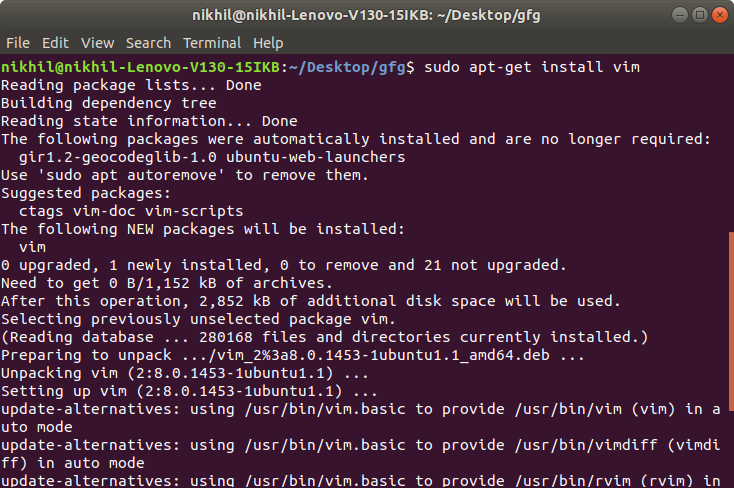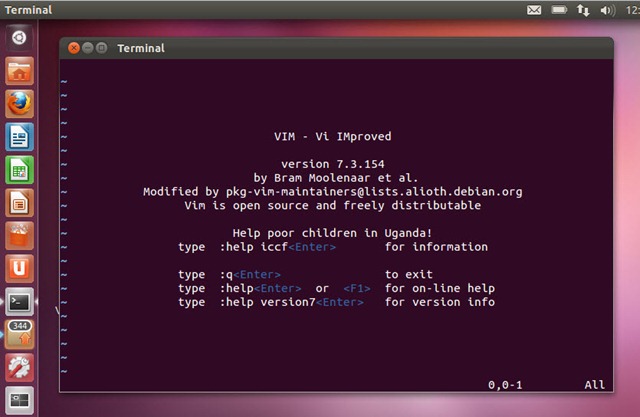


- #Sudo apt get install vim how to
- #Sudo apt get install vim update
- #Sudo apt get install vim download
Install vim-go Install Using vim8 native package manager git clone ~/.vim/pack/plugins/start/vim-goĪfter finishing installation, the vim-go project has a good tutorial of how to use the plugin in details. sudo add-apt-repository ppa:jonathonf/vim sudo add-apt-repository ppa:longsleep/golang-backportsĪdd the latest ppa. Using Latest Package Install The Latest Go VersionĪdd the latest version of Go ppa. curl -fLo ~/.vim/autoload/plug.vim -create-dirs \Īdd this to. Using vim-plugĪnother alternative for vim-go installation is by using vim-plug. To test the installation, open vim and try to run some vim-go command, such as :GoInstallBinnaries. Then install vim-go to be loaded by pathogen by executing this command. mkdir -p ~/.vim/autoload ~/.vim/bundle & \ Basically we need to run this command below. Head to vim-pathogen github for the detail guideline.

Using vim 8 native package manager (in the next section).To install, head to vim-go github for the detail. Vim-go is vim plugin that add some useful features for go development using vim. Install VimĬheck the installed version by running vim -version. Using Default Package from Current Ubuntu Version Install GoĬheck the installed version by running go version. The other approach is to use the latest version by using ppa. The first approach is to use whatever version available in Ubuntu 16.04. You can check out other tutorials shown below to expand your knowledge.In high level there are two ways to install the required golang and vim. In this tutorial, you discovered how you can install Vim editor on your Ubuntu system using APT, SNAP, and Make. To remove Vim, we can run the command: sudo apt remove vim -y You can verify by running the command: vim -vĬonfirm the installed version. Once the build process is complete, run the command below to install and configure Vim on your system. Once the repository has been cloned, navigate into the src directory and run the make command as: cd vim You can run the command below to clone the repo: git clone
#Sudo apt get install vim download
The next step is to download Vim from the official repository. How do you install vim in Linux using apt-get command How to Install vim with apt-get apt-get install vim -y. The command above will the required packages such as ncurses, git, make, gcc, build-essential, etc. Start by installing the required packages with the command: sudo apt install libncurses5-dev libncursesw5-dev git make gcc build-essential -y You can also manually build the Vim package from source. Install Vim with the command: sudo snap install -classic vim
#Sudo apt get install vim update
Ensure the snap system is installed with the command: sudo apt update & sudo apt install snapd We can also use the Ubuntu snap system to install the vim editor on your system. This command should download the latest Vim editor and configure it on your system. Next, run the command below to install Vim. Start by updating the repository index with the command: sudo apt-get update The simplest and most straightforward method to have Vim on your Ubuntu system is to use the default package manager. Method 1 - Install Vim Via Package Manager Build Tools such as git, make, build-essentials, gcc, etc.

Administrative permissions to install and configure packages.Vim offers a wide range of features, including syntax highlighting, auto-completion, macro recording, plugin support, and many more. It is often a popular choice among programmers and system administrators for editing source code, configuration files, and other types of text-based files. Vim is written in C and is available on a variety of operating systems, including Unix, Linux, and Windows. How to Install and Configure VIM Plugin in Ubuntu


 0 kommentar(er)
0 kommentar(er)
